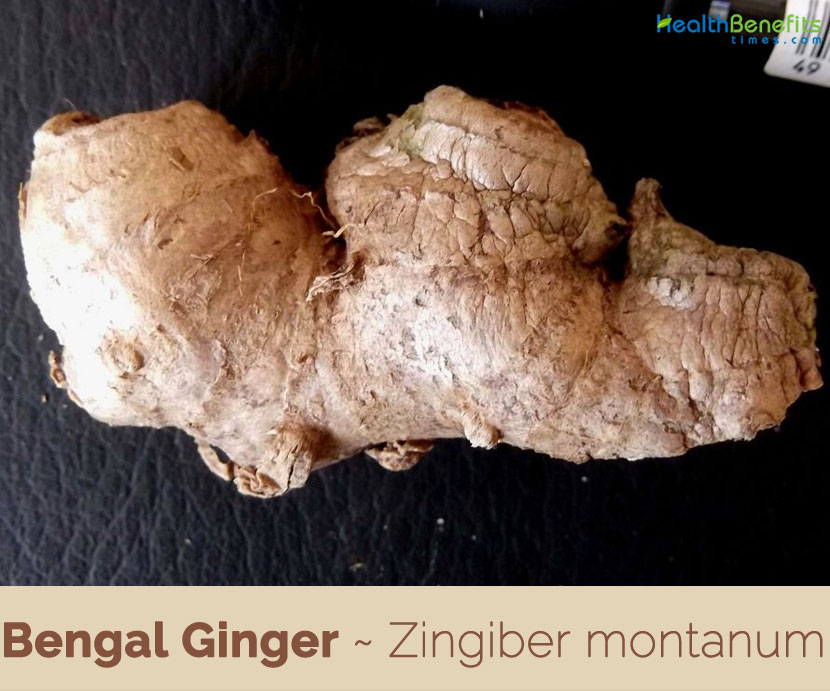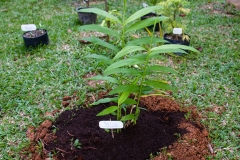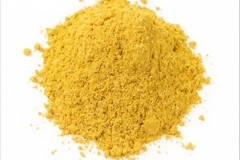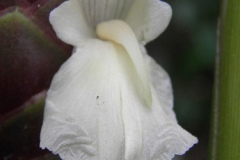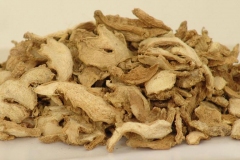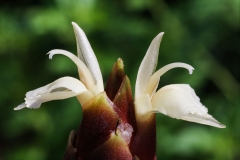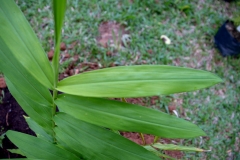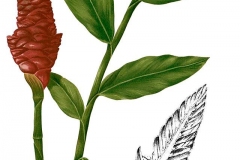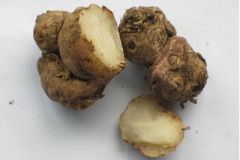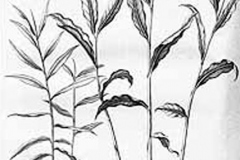Plant description
Bengal Ginger is an herbaceous, perennial, clumping herb that grows about 2 m high. The plant is found growing in wetland habitats, in moist and shady forest areas, partially shaded evergreen and monsoon forests, and secondary forests, open habitats at forest edges, disturbed sites and bamboo thickets on rocky soils. The plant prefers well-drained, sandy lam or loamy clay soils. Rhizomes are horizontal creeping, tuberous, cylindrical to ovoid, irregular, palmately and profusely branched, laterally compressed and strongly aromatic with yellow flesh color. Pseudostem is cylindrical, erect, enveloped by leafy sheaths and reaching 1.2–1.8 m high.
Leaves
Leaves are alternate, distichous, simple, sub sessile or shortly petiolate, lanceolate-oblong and 3.5–5.5 cm wide and 18–35 cm long. Leaf sheaths are oblong, with membranous margins. Ligules are ovate and membranous margins. Ligules are ovate and membranous. It is stalk less, velvet-hairy or velvet-hairy along midrib only on the lower surface.
Inflorescence
Inflorescence is radical. Spikes are cylindrical, fusiform or cone like, borne on a peduncle spike (scape) arising from rhizome and 8–60 cm high with 5–7cataphylls. Bracts are divided into outer and inner, spirally arranged, very dense, persistent and red or purplish brown. The outer is broadly ovate to sub orbicular and cucullate, while the inner is ovate and glabrous.
Flowers and Fruits
Flowers are ebracteolate, bisexual, zygomorphic and epigynous. Calyx is 1.2–1.5 cm, membranous, glabrous and white. Corolla has 4 lateral lobes and is linear- lanceolate, yellowish-white and reddish lineolate on margins. Labellum is white or pale yellow and sub orbicular. Apex is emarginate; central lobe is broadly rounded; stamen is 1 cm long and pale yellow. Ovary is 3 loculed, inferior, 3–4 mm long and pubescent. Fertile flowers are followed by capsule that is ovoid to sub globose and 1–1.5 cm in diameter.
History
Zingiber montanum is considered native to India and Southeast Asia – Myanmar, Thailand, Malaysia and Indonesia. The species is considered native to Vietnam in Wiart but naturalized according to the Kew World Checklist. In Borneo, it is listed as naturalized in the Kew World Checklist, whereas USDA-ARS ( 2014 ) lists the species as native. The species has been widely cultivated across tropical Asia for food flavoring, often as a substitute for Z. officinale, and for a variety of medicinal uses.
- Bengal Ginger is widely used in folklore remedies as a single plant or as component of herbal recipes in Thailand and many Asian countries for the treatment of inflammation, sprains and strains; rheumatism, muscular pain, wounds and asthma; cough and respiratory problems; and as a mosquito repellant, a carminative, a mild laxative and an anti-dysenteric agent.
- Rootstock is considered to be restorative and carminative and to relieve flatulence.
- Rhizomes are used for food flavoring and are used medicinally in tropical Asia, primarily as a carminative and stimulant for the stomach and against diarrhea and colic.
- Rhizomes are consumed to relieve asthma and muscle and joint pain in Thai traditional medicine.
- Rhizome of Bengal Ginger and the seed of Nigella sativa are two ingredients in Thai traditional medicine to relieve dysmenorrhea and adjust the menstrual cycle.
- Chamratpan and Homchuen reported that the natives of upper northeastern of Thailand use Bengal Ginger to cure paralysis symptoms and sprains and as massage cream.
- Bengal Ginger has been used for pain relief in arthritis including osteoarthritis and rheumatoid arthritis.
- Various lotions and decoctions are applied to swellings, rheumatism, bruise, numb feet and other painful parts.
- The species is the prime ingredient in massage oil to relieve muscle pain in Thailand
- Rhizomes are taken against asthma, while in Laos; it is applied against abscesses, fever, colic, diarrhea and other intestinal disorders, a depurative, as well as a poison antidote.
- In Indonesia, Bengal Ginger rhizome has been used in traditional medicine as blood purifier, vermifuge, laxative, expectorant, carminative, body warming and slimming agents in jamu.
- It is also used in Indonesian traditional medicine as a vermifuge and an analeptic for the uterus and to relieve pain, colic, diarrhea and rheumatism
- Rhizome is used in decoction for constipation, flatulence or colic and as a vermifuge.
- Bengal Ginger is used externally for fever and as post-partum medication in childbirth in Sarawak.
- Bengal Ginger is pounded alone or with Gendarussa into a poultice for swelling and rubbed on the body after childbirth.
- Boiled with ginger and Acorus, the decoction is used hot for bathing during fevers.
- Bengal Ginger is prescribed in applications for numb feet, gonorrhea and pains in various places and as a cosmetic.
- Leaves boiled with pepper and the decoction drunk for stomachache.
- Rhizome is used as an antidote to snakebite and stimulant, is carminative, is given in diarrhea and colic and is used to treat fever and intestinal disorders in India.
- Traditional medical practitioners use rhizomes in the treatment of piles and cough in Manipur.
- Bengal Ginger rhizome has been extensively used as a folk medicine to ameliorate peptic ulcer at northern part of Bangladesh.
- Bengal Ginger oil cream for medical purpose is available under trade name Plygesal in Thailand.
- This cream has been developed to relieve muscular pain, bruises, sprains and swelling.
- Nowadays, they are sold in drugstores as anti-inflammatory drug which has various forms such as cream, gel, balm and oil.
- Plaitanoids, an extract from Bengal Ginger rhizomes, containing arylbutanoids and essential oil, have been developed and used as a raw material for more than 30 products such as toothpaste, shampoo, skin whitening, massage oils and essential oils for spas.
- Twin lotus has added Bengal Ginger extract to its toothpaste, while aesthetic clinic uses it as a major component in soaps, shampoos and lotions.
- Recently, it has been used as skin whitening and anti-ageing agent.
- Plai has long been regarded by Thai massage therapists as one of those oils necessary to have in their kit to combat joint and muscle problems.
- It is well known that Bengal Ginger essential oils have been shown to cure acne, bruises, burnt skin, skin inflammation, muscle pain, insect bite and asthmatic symptoms.
- They are even proven to relive cough and respiratory symptoms as well.
- Pounded rhizome is used as a poultice against headache, and in a variety of medicinal mixtures in Indonesia.
- Rhizome is administered internally as a vermifuge in Malaysia and for postpartum medication.
- In Laos, it is applied against abscesses, fever, colic, diarrhea and other intestinal disorders, a depurative, as well as a poison antidote.
- In Thailand, the species is the prime ingredient in massage oil to relieve muscle pain, and the rhizomes are taken against asthma.
- In Northeast India, oral consumption of the rhizome paste was reported to treat dyspepsia and stomach bloating.
- In Rajsthali, fresh juice is given to the female for the treatment of amenorrhea.
- Warmed leaves are applied over body to get relief from pain.
- In Moheshkhali Island, cooked rhizome is given to mothers after childbirth for quick recovery from weakness.
Culinary uses
- Rhizomes are used for food flavoring in Thailand.
- Rhizome has a strong camphoraceous odor; warm, spicy, bitter taste and fleshy; bright yellow color and is strongly scented and is used as a flavoring agent in many food preparations and as a substitute for true ginger.
- It is also used as a substitute for and an adulterant of Zingiber officinale in the global ginger spice trade.
- Flowers and young shoots are eaten as side dish vegetables for appetizers.
- The rhizome is used as a condiment.
Other facts
- Bengal ginger has been shown to exhibit pesticidal and fungicidal activity.
- Bengal ginger roots are used for amulets attached to necklaces for babies and children by the native Sakai in Peninsular Malaysia for occult purposes.
- The Malays chew the rhizome and spit it over the abdomen of an infant.
- Root is sometimes used for making an arrow poison.
- The plant tends to be avoided by animals. It is therefore sometimes planted around the edges of rice fields to try and protect them from damage.
References:
https://www.itis.gov/servlet/SingleRpt/SingleRpt?search_topic=TSN&search_value=817992#null
https://www.cabi.org/isc/datasheet/57536
https://plants.usda.gov/core/profile?symbol=ZIMO2
https://en.wikipedia.org/wiki/Zingiber_montanum
https://indiabiodiversity.org/species/show/243791
https://www.wikidata.org/wiki/Q15336912
https://npgsweb.ars-grin.gov/gringlobal/taxonomydetail.aspx?413101
http://www.tn-grin.nat.tn/gringlobal/taxonomydetail.aspx?id=413101
http://www.theplantlist.org/tpl1.1/record/kew-273343
https://www.flowersofindia.net/catalog/slides/Mountain%20Ginger.html
http://tropical.theferns.info/viewtropical.php?id=Zingiber+montanum
Comments
| Bengal Ginger Quick Facts | |
|---|---|
| Name: | Bengal Ginger |
| Scientific Name: | Zingiber montanum |
| Origin | India and southeast Asia – Myanmar, Thailand, Malaysia and Indonesia |
| Shapes | Capsule is ovoid to sub globose and 1–1.5 cm diameter |
| Taste | Hot and camphorous |
| Health benefits | Beneficial for inflammation, sprains, rheumatism, muscular pain, wounds, asthma, respiratory problems, diarrhea, dysmenorrhea, flatulence as well as a poison antidote |
| Name | Bengal Ginger |
|---|---|
| Scientific Name | Zingiber montanum |
| Native | India and southeast Asia – Myanmar, Thailand, Malaysia and Indonesia |
| Common Names | Bengal Ginger, Bitter Ginger, Cassumunar Ginger, Thai Ginger, Cassumar ginger, Bengal root, Mountain Ginger |
| Name in Other Languages | Assamese: Bor-ada Bangladesh : Bon Ada Bengali: Bun-Ada, Moorada Burmese : Meik-Thalin Chinese : Ye Jiang Cuba : Jengibre Amargo Dominican Republic : Jengibre Amargo, Jengibre Cimarron English: Bengal ginger, Cassumunar ginger, Cassumar ginger, Thai ginger, Bengal root, Mountain Ginger French : Gingembre De Siam, Gingembre Marron German : Blockzitwer, Gelber Zitwer, Zitwer Hindi: Bun-Ada, Jangli adrak (जंगली अदरक), Banada Indonesia : Banglai, Bangle, Bengle, Mungle, Unin Makei, Banggele, Bungle, Panini, Bangle, Bengle, Nunglai, Kunit Bolai, Pandhiyang, Bale, Kunik Bolai, Mugle, Bengle, Bungle, Baglai, Baniai, Banglai, Bunglai, Bangle, Kunit Bolai, Kunyit Bolai Mugle, Bengle, Bungle, Baglai, Baniai, Banglai, Bunglai,; Bangle, Kunit Bolai, Kunyit Bolai, Pandhiyang, Panglai Japanese : Shikyou Kannada: Nisa, Malabri Halad Malayalam: Kaattu-inchi Malaysia : Bangle, Bolai, Boleh, Bonglai, Bonglaibulai, Bungelai, Kunyit Bolai, Kunyit Terus Putih, Lampoyang Kuning, Lia Betong, Tepus Merah Manipuri: Tekhaoyaikhu, Naga-sing Marathi: Nisa, Malabri Halad , nisan, nisana, penlekosht Nepalese : Van Aduvaa, Ardrakam Puerto Rico : Jengibre Colorado Sanskrit: Vana-Ardraka Spanish : Jengibre, Jengibre Amargo Tamil: Kattu Ingi, Vanarttirakam Tangkhul: Ram hui Telegu: Car-Puspoo Thai : Wan Fai, Wan Fi, Plai, Phlai, Plai, Bpulai, Puloi, Pu Loei, Min Sa Lang, Pu loi (ปูลอย), Pu loei (ปูเลย), Phlai (ไพล), Min sa lang (มิ้นสะล่าง) , Wan fai (ว่านไฟ) Vietnamese : Gùng Tia |
| Plant Growth Habit | Herbaceous, perennial, clumping herb |
| Growing Climates | Wetland habitats and in moist and shady forest areas, partially shaded evergreen and monsoon forests, secondary forests, open habitats at forest edges, disturbed sites and bamboo thickets on rocky soils |
| Soil | Prefers well-drained, sandy lam or loamy clay soils |
| Plant Size | About 2 m |
| Rhizomes | Horizontal creeping, tuberous, cylindrical to ovoid, irregular, palmately and profusely branched, laterally compressed and strongly aromatic with yellow flesh color |
| Pseudo stem | Cylindrical, erect, enveloped by leafy sheaths and reaching 1.2–1.8 m high |
| Leaf | Alternate, distichous, simple, sub sessile or shortly petiolate, lanceolate-oblong and 3.5–5.5 cm by 18–35 cm long. Leaf sheaths are oblong, with membranous margins; ligules are ovate and membranous margins; ligules are ovate and membranous |
| Flower | Ebracteolate, bisexual, zygomorphic and epigynous. Calyx is 1.2–1.5 cm, membranous, glabrous and white. Corolla has 4 lateral lobes and is linear- lanceolate, yellowish-white and reddish lineolate on margins. |
| Fruit Shape & Size | Capsule is ovoid to sub globose and 1–1.5 cm diameter |
| Propagation | By seeds and rhizome division |
| Flavor/Aroma | Mixture of ginger, camphor and turmeric |
| Taste | Hot and camphorous |


